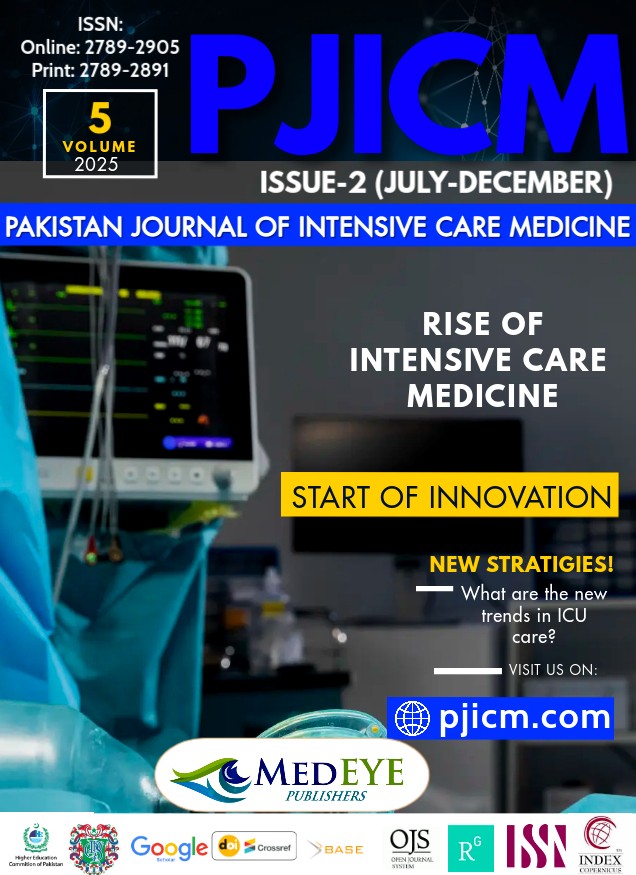ETIOLOGICAL SPECTRUM OF IATROGENIC UROGENITAL FISTULA IN PATIENTS PRESENTING TO TERTIARY CARE HOSPITAL
DOI:
https://doi.org/10.54112/pjicm.v5i02.200Keywords:
Iatrogenic Urogenital Fistula, Vesicovaginal Fistula, Surgical Injury, Cesarean Section, Abdominal HysterectomyAbstract
Background: Iatrogenic urogenital fistula is a serious and preventable complication of gynecological and obstetric procedures, leading to significant physical, psychological, and social consequences. Understanding its etiological spectrum is essential for improving surgical safety and patient outcomes. Objective: To assess the etiological spectrum of iatrogenic urogenital fistula at a tertiary care hospital. Study Design: Cross-sectional observational study. Setting: Department of Obstetrics & Gynaecology, Hayatabad Medical Complex, Peshawar, Pakistan. Duration of Study: From March 2025 to September 2025. Methods: Eighty patients aged 18–45 years with a confirmed diagnosis of iatrogenic urogenital fistula were included. Data were collected using a structured pro forma that documented age, BMI, socioeconomic status, occupation, education level, and residence. The etiology of the fistula was recorded for each patient. Diagnosis was confirmed through examination under anesthesia and cystoscopy. Statistical analysis, including assessment of associations between etiology and patient characteristics, was performed using appropriate tests with a significance threshold of P < 0.05. Results: The mean age of patients was 33.08 ± 7.94 years, and the mean BMI was 24.64 ± 2.06 kg/m². Abdominal hysterectomy was the leading cause of fistula, identified in 29 cases (36.2%), followed by cesarean section in a scarred uterus in 24 cases (30.0%), hysterectomy performed for postpartum hemorrhage in 10 cases (12.5%), cesarean section in an unscarred uterus in 12 cases (15.0%), and dilatation and curettage in 5 cases (6.2%). A significant association was observed between etiology and age (P < 0.001), with abdominal hysterectomy more common in older patients and cesarean-related etiologies more common among younger women. Conclusion: Abdominal hysterectomy and cesarean section, particularly in previously scarred uteri were the most common causes of iatrogenic urogenital fistula. Abdominal hysterectomy was associated with older age, whereas cesarean-related causes were more common among younger patients. Improved surgical training and perioperative vigilance may help reduce the incidence of this preventable condition.
References
Saeed S, Nawaz N, Murtaza B, Mahmood A. Urogenital fistula in females: a four-year experience. Pak Armed Forces Med J. 2016;66(3):361-6. (No DOI available.)
Hilton P. Urogenital fistula in the UK: a personal case series managed over 25 years. BJU Int. 2012;110(1):102-10. https://doi.org/10.1111/j.1464-410X.2011.10630.x
United Nations. One UN Pakistan: annual report 2014. Islamabad: United Nations; 2015 [cited 2025 Sep 20]. Available from: http://www.un.org.pk/wp-content/uploads/2015/12/2014-UN-Pakistan-Report_web1.pdf (No DOI available.)
Adler AJ, Ronsmans C, Calvert C, Filippi V. Estimating the prevalence of obstetric fistula: a systematic review and meta-analysis. BMC Pregnancy Childbirth. 2013;13:246. https://doi.org/10.1186/1471-2393-13-246
Ngongo CJ, Raassen TJIP, Mahendeka M, Lombard L, Van Roosmalen J, Temmerman M. A retrospective review of genital fistula occurrence in nine African countries. BMC Pregnancy Childbirth. 2022;22(1):744. https://doi.org/10.1186/s12884-022-05051-w
Raassen TJIP, Ngongo CJ, Mahendeka MM. Iatrogenic genitourinary fistula: an 18-year retrospective review of 805 injuries. Int Urogynecol J. 2014;25(12):1699-706. https://doi.org/10.1007/s00192-014-2445-3
Mpunga Mafu M, Banze DF, Nembunzu D, Maroyi R, Paluku J, Kinja R, et al. Frequency and management of non-obstetric fistula in the Democratic Republic of Congo: experience from the Fistula Care Plus project. Trop Med Int Health. 2020;25(6):687-94. https://doi.org/10.1111/tmi.13394
Tripathi V. Iatrogenic fistula and cesarean section safety in low resource settings: ensuring quality in a context of rapidly increasing volume. Abuja: West African College of Surgeons Annual General Meeting and Scientific Conference; 2020. (No DOI available.)
Tasnim N, Bangash K, Amin O, Luqman S, Hina H. Rising trends in iatrogenic urogenital fistula: a new challenge. Int J Gynaecol Obstet. 2020;148(Suppl 1):33-6. https://doi.org/10.1002/ijgo.13037
Hilton P. Trends in the aetiology of urogenital fistula: a case of retrogressive evolution. Int Urogynecol J. 2016;27(6):831-7. https://doi.org/10.1007/s00192-015-2919-y
Srichand P, Hassan N, Shaikh N, Sultana F, Talpur Z, Farheen G. Aetiological pattern of iatrogenic urological fistula: is the scenario changing? J Soc Obstet Gynaecol Pak. 2021;11(4):234-7. (No DOI available.)
Osman SA, Al Badr AH, Malabarey OT, Dawood AM, AlMosaieed BN, Risk DEE. Causes and management of urogenital fistulas: a retrospective cohort study from a tertiary referral center in Saudi Arabia. Saudi Med J. 2018;39(4):373-8. https://doi.org/10.15537/smj.2018.4.21515
Obarisiagbon EO, Olagbuji BN, Onuora VC, Oguike TC, Ande AB. Iatrogenic urological injuries complicating obstetric and gynaecological procedures. Singapore Med J. 2011;52(10):738-41. (No DOI available.)
Mathevet P, Valencia P, Cousin C, Mellier G, Dargent D. Operative injuries during vaginal hysterectomy. Eur J Obstet Gynecol Reprod Biol. 2001;97(1):71-5. https://doi.org/10.1016/S0301-2115(00)00484-X
Mteta KA, Mbwambo J, Mvungi M. Iatrogenic ureteric and bladder injuries in obstetric and gynaecologic surgeries. East Afr Med J. 2006;83(2):79-85. https://doi.org/10.4314/eamj.v83i2.9392
Zheng AX, Anderson FW. Obstetric fistula in low-income countries. Int J Gynaecol Obstet. 2009;104(2):85-9. https://doi.org/10.1016/j.ijgo.2008.09.011
Hawkins L, Spitzer RF, Christoffersen Deb A, Leah J, Mabeya H. Characteristics and surgical success of patients presenting for repair of obstetric fistula in western Kenya. Int J Gynaecol Obstet. 2013;120(2):178-82. https://doi.org/10.1016/j.ijgo.2012.08.014
Downloads
Published
How to Cite
Issue
Section
License
Copyright (c) 2025 K ALAM , M RIAZ , L BIBI , S KHATOON , . JAWAIRIA

This work is licensed under a Creative Commons Attribution-NonCommercial 4.0 International License.












